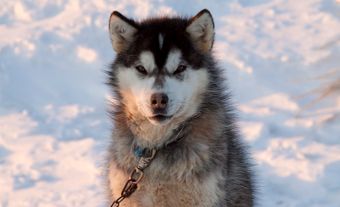
Description
The Salish Woolly dog was a small, usually white, long-haired dog with prick ears, curled tail, fox-like face, and a thick coat.
When Captain George Vancouver observed the Salish Woolly dog around the Puget Sound in 1792, he thought that it looked like a larger version of a Pomeranian. According to Spanish naval officers Cayetano Valdés y Flores and Dionisio Alacalá Galiano on their visit to the Pacific Northwest in 1792, the dogs did not bark, but instead “simply [had] a miserable howl.”
Today, many scholars have compared the Salish Woolly dog to the contemporary dog breeds of the Japanese Spitz and the American Eskimo.
Evolution
Just over 14,000 years ago, domestic dogs evolved from two separate wolf populations: one in Asia and the other in Europe. Between 14,000 and 6,400 years ago, humans started to bring Asian domestic dogs westward, breeding them with the European domestic dogs.
Salish Woolly dogs are more closely related to early Asian breeds of domestic dogs than European ones. Nineteenth-century naturalist John Keast Lord believed that the dogs originated from a Japanese shipwreck on the Pacific Coast, but had no evidence for this claim. Scholars do know that the Salish Woolly dog was a breed developed before European contact; the oldest remains of the dog were found in Puget Sound and the Strait of Georgia, and date from 4,000 years ago.
Distribution and Habitat
The Salish Woolly dogs lived throughout the Coast Salish territories, including on the southern end of Vancouver Island, the Strait of Juan de Fuca, Puget Sound, the Olympic Peninsula, the Strait of Georgia, and the Lower Fraser River. Often the dogs would live in packs of about 20 to 30. The dogs were fed a diet of fish and elk tallow (rendered fat) to keep their coats strong so their hair could be used for wool. In order to maintain the breed, Coast Salish peoples kept Salish Woolly dogs from other domestic dogs. This meant that the Salish Woolly dogs were often confined to small islands around Vancouver Island and the San Juan Islands. When the dogs lived on isolated islands, they were often left alone during the spring and summer, with their owners returning in the autumn to shear them. For the Twana-speaking peoples of Puget Sound, the Salish Woolly dogs would share plank houses with their owners while the hunting dogs would live outside. Like other domestic dogs, the Salish Woolly dog would most likely have bred about every six months.
Coast Salish Clothing and Blankets
It is believed that the dogs were raised for their hair, which Coast Salish peoples mixed with mountain goat hair to produce clothing and blankets. When the dogs’ coats were long enough, female weavers washed the animals’ hair with a white clay to remove dirt. The weavers then used a sharp stone or knives made of mussel shells to shear the dogs like sheep, cutting the hair close to the skin. The cut hair was then stored with dried clay to extract oil and kill any parasites. The dogs may have produced up to three coats a year.
Although there is both Indigenous oral history and settler written history of dog hair being used for blankets, very few examples of dog hair blankets have been found. Some believe that because dog hair was so common it was likely used for less important blankets. As such, these blankets may have been used more often and therefore deteriorated faster. It is also believed that dog hair was mainly used in textiles woven before 1862, when sheep wool became common in the Coast Salish territories. While some examples of blankets of dog hair mixed with other fibres (e.g. mountain goat) exist, researchers are only aware of one surviving blanket of primarily dog hair. This blanket is housed at the Burke Museum of Natural History and Culture in Seattle, Washington.
Relationship with Humans
Salish Woolly dogs were most likely owned by high-ranking families within Coast Salish communities. Among the Olympic Peninsula Indigenous nations, the dogs were owned by women and inherited through the female line.
The dogs were highly valued in Coast Salish societies since blankets made of their fur were considered a basic source of wealth during potlatches. Salish Woolly dogs were often buried wrapped in a blanket to honour them.
Extinction
The Salish Woolly dog’s population declined throughout the 1800s. The increased presence of Europeans meant the settlers’ dogs bred with the Salish Woolly dogs, decimating the latter’s population. In addition, Indigenous populations also declined due to land displacement and disease caused by settler colonization. Finally, by the 1820s, fur-trading posts had introduced inexpensive, machine-made blankets from England. These European blankets meant there was no need to keep the dogs for their hair, especially since feeding a herd of dogs required salmon that could otherwise be used to feed people. By 1900, the long, woolly fur characteristics of the Salish Woolly dog had disappeared, though there were a number of rare sightings of woolly dogs on reservations up to 1940.
There is currently not much physical evidence left of the Salish Woolly dog. Artist Paul Kane painted “A Woman Weaving a Blanket” between 1849 to 1856, which depicts either a Songhees or Saanich weaver and a prominent woolly white dog. The painting and other sketches of the dog by Kane can be found at the Royal Ontario Museum. In 1859, naturalist C.B.R. Kennerly collected the pelt of the American ethnologist George Gibbs’ “famous Indian dog, Mutton” for the Smithsonian Institution’s National Museum of Natural History. This pelt is thought to be the only remaining Salish Woolly dog specimen.

 Share on Facebook
Share on Facebook Share on X
Share on X Share by Email
Share by Email Share on Google Classroom
Share on Google Classroom






